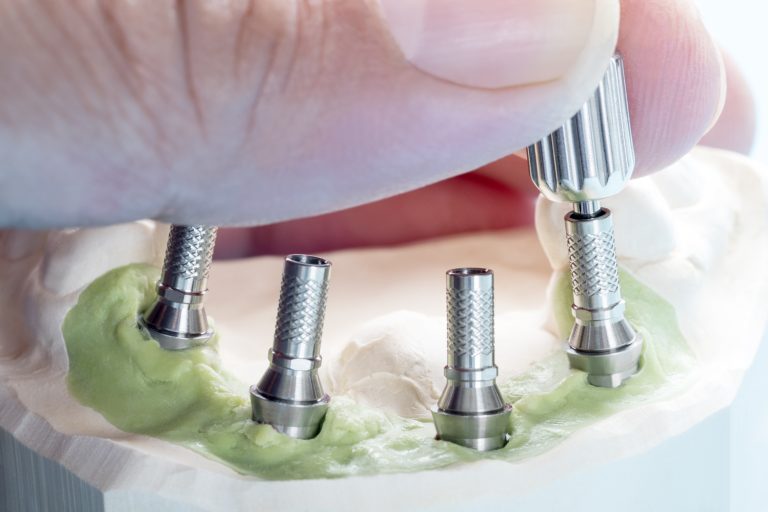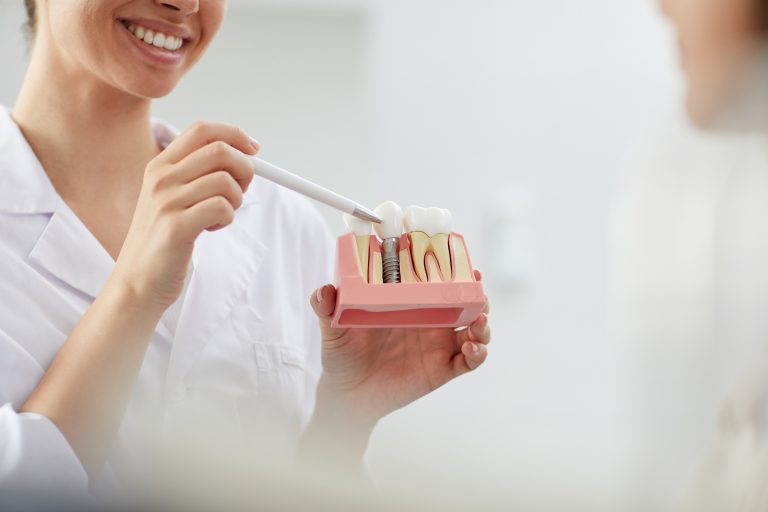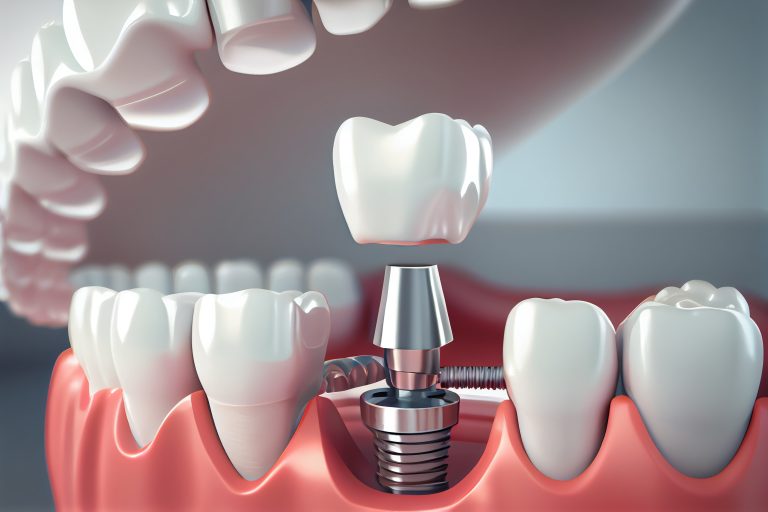


Immediate İmplant Nedir?
Immediate implant, diş çekimi ile aynı seansta implantın yerleştirilmesi olarak tanımlanan yenilikçi bir tedavi yöntemidir. Geleneksel implant tedavilerinde, diş çekiminden sonra çene kemiğinin iyileşmesi için birkaç ay beklenmesi gerekir Immediate implant tedavisinde ise bu süreç hızlandırılır. Diş çekiminden hemen sonra implant yerleştirme işlemi gerçekleştirilerek kemik kaybı ve dişsiz kalma süresi minimuma indirilir.
Immediate implant prosedürü, estetik ve fonksiyonel kaygılara hızlı çözümler sunmakla birlikte hastaların günlük yaşamlarına daha kısa sürede geri dönmelerini sağlar. Özellikle tek diş kayıplarında, çoklu diş eksikliklerinde ve tüm dişlerin eksikliğinde kullanılan çeşitli yöntemlerle hem estetik hem de fonksiyonel bir gülüş sağlanabilir. Çene kemiğinin mevcut durumu ve diş eti sağlığı gibi faktörler hasta özelinde tedaviye uygunluğu belirler. Bu sayede diş çekimi sonrası estetik kaygılar yaşamadan, aynı gün geçici dişlere sahip olma avantajı sağlanabilir.
Immediate implant tekniği; zaman tasarrufu sağlaması, çene kemiği desteği ile uzun süreli stabilite sunması ve estetik görünümü hızla geri kazandırması nedeniyle sıklıkla tercih edilen modern bir diş hekimliği prosedürüdür. Uygun kemik kalitesi ve yoğunluğuna sahip hastalarda tedavinin başarı oranı son derece yüksektir.
Immediate İmplant Nasıl Yapılır?
Immediate implant, kapsamlı bir planlama ve detaylı hazırlık süreci gerektiren bir diş hekimliği tedavisidir. İlk olarak tedavi adayının ağız ve çene yapısı detaylı bir şekilde değerlendirilir. Bu süreçte, panoramik röntgen ve üç boyutlu tomografi gibi görüntüleme teknikleri kullanılır. Çene yapısının kemik yoğunluğu ve implantın stabilitesini destekleyip desteklemeyeceği radyolojik incelemelerle belirlenir.
Uygun koşullar sağlandığı takdirde lokal anestezi ile tedaviye başlanır. Lokal anestezi sayesinde hasta herhangi bir ağrı hissetmeden işlem gerçekleştirilir. Eğer implant uygulaması yapılacak bölgede çekilmesi gereken dişler varsa öncelikle diş çekimleri gerçekleştirilir. Diş çekim işlemi sırasında mevcut kemik dokusunun korunmasına özen gösterilir.
Ardından bölge implant yerleştirilmesi için hazır hâle getirilir. Çekim bölgesi uygun şekilde temizlenir ve implantın yerleştirileceği yuvalar oluşturulur. İmplant yerleştirildikten sonra stabilite sağlandığı takdirde geçici sabit protezler implantın üzerine adapte edilir. Geçici protezler ise hem estetik hem de fonksiyonel ihtiyaçları karşılamak için tasarlanır. Ancak implantın çene kemiği ile tamamen kaynaşabilmesi için belirli bir bekleme süresine ihtiyaç duyulur.
Kalıcı diş protezleri, çene kemiği ile implantın ideal entegrasyonu sağlandığında uygulanır. Bu süreç alt çenede yaklaşık beş hafta, üst çenede ise on hafta kadar sürebilir. İmplantın tam stabilizasyonu sağlandığında, kalıcı protezler prova edilerek implant üzerine sabitlenir
Immediate İmplant Uygulamasının Aşamaları
Immediate implant tedavisi, belirli aşamalar doğrultusunda gerçekleştirilen ve yüksek cerrahi hassasiyet gerektiren bir süreçtir. Tedavinin başarısını artırmak ve hastanın konforunu sağlamak için immediate implant uygulamasının tüm aşamaları titizlikle planlanmalı ve uygulanmalıdır.
Muayene ve Planlama
Tedavinin ilk aşaması detaylı bir muayene ve planlama sürecinden oluşur. Diş hekiminiz, ağız ve çene yapınızın genel sağlığını değerlendirir. Çene kemiği yoğunluğu ve kalitesi, diş implantının yerleştirilip yerleştirilemeyeceğini belirleyen kritik faktörlerdir. Bunun yanı sıra potansiyel enfeksiyon riskleri ve mevcut durumlar da analiz edilir.
Muayene sırasında alınan üç boyutlu görüntüler ve dijital planlama teknolojileri ile implantın yerleştirileceği alan ve protezin tasarımı belirlenir. Bu aşama, işlemin başarısını doğrudan etkilediği için son derece önemlidir.
Cerrahi Süreç ve İmplant Yerleştirilmesi
Cerrahi işlemler sırasında gerekli görülmesi hâlinde diş çekimi yapılır. Çekim alanı, implant yerleştirilmeden önce dikkatlice temizlenir ve tedaviye hazır hâle getirilir. Çene kemiğine uygun yuvalar açılır ve implantın stabil bir şekilde yerleştirilmesi sağlanır. Bu süreçte cerrahi kılavuzlar kullanılarak implant doğru bir şekilde pozisyonlandırılır.
Eğer çene kemiğinde eksiklik veya sorun varsa çekim sırasında kemik tozu ya da greft uygulaması yapılabilir. Böylece implantın çene kemiği ile uyumu sağlanarak uzun süreli stabilite için temel hazırlanır.
Geçici Protez Uygulaması
İmmediate implant tedavisinde, implant yerleştirilmesinin ardından hastaya geçici protezler uygulanır. Bu protezler, estetik bir görünüm sağlar ve çiğneme fonksiyonlarını kısmen yerine getirmeye yardımcı olur. Geçici protez kullanımı, implantın tam stabilizasyonu sağlanana kadar sürer. Bu süreçte, implantın üzerine gelen basınç ve kuvvetlerin minimum seviyede tutulması kalıcı sonuçlar açısından önemlidir.
Kaynaşma Süreci (Osseointegrasyon)
İmplantın çene kemiği ile tam entegrasyonu için belirli bir süre gereklidir. Bu süre zarfında hasta, diş hekiminin önerilerine dikkat etmeli ve belirli beslenme alışkanlıklarına uymalıdır. Yumuşak gıdalar tüketmek, ağız hijyenine özen göstermek ve düzenli kontrol muayeneleri bu dönemin bir parçasıdır.
Kalıcı Protezlerin Uygulanması
Çene kemiğinin yeterli iyileşme ve entegrasyonu sağladığı tespit edildiğinde kalıcı protezler yerleştirilir. Kalıcı protezler hastanın hem estetik hem de fonksiyonel ihtiyaçlarını karşılamak üzere kişi özelinde tasarlanır. Kalıcı protezlerin uygulanması sırasında protezin çevredeki dokularla ve implantla uyumu detaylı şekilde kontrol edilir.
Immediate implant uygulaması, hastalara klinikten dişleri eksiksiz bir şekilde ayrılma imkânı sunan hızlı ve etkin bir yöntemdir. Tedavi aşamaları, cerrahi uygulamalar ve geçici protez kullanımıyla tamamlanır. Bu süreçte diş hekiminizin önerilerine uymak, tedavinin uzun vadeli başarısı açısından kritik öneme sahiptir.
Bize Mesaj Gönderin
Randevu Saatleri
Pazartesi – Cuma: 08:00 – 18:00
Pazar günleri ve resmi tatillerde kapalıyız.
İletişim
Yeni Mahallesi İntizam Sokak No:7 Pendik / İstanbul
0216 390 95 80
0505 372 09 26
Kliniğimizde, sıcak bir karşılama, şeffaf iletişim ve üstün hizmet kalitesiyle, diş sağlığı konusundaki tüm ihtiyaçlarınıza cevap vermeye hazırız.
Kaplamalarımla alakalı gitmiştim kaplamalarımın altında kistler oluşmuştu. İmplant takıldı şuan çok memnunum .Esra hanımdan önce 3 -4 tane dişçiye gittim ama hep problemler çıkardılar kaplamayı takarken dişlerimi kökten kırdılar. En son Esra hanımı önerdiler gittim ve çok memnun kaldım . Eli çok hafif ve işi bilen bir hekim Kanal tedavisi ile dişlerimin tamamını kurtardı. yakınlarıma,aileme tavsiye ettim . Ailemden de gidenler var.

TR

TR
Sıkça Sorulan Sorular: “İmmediate İmplant“
İyileşme süreci hastadan hastaya değişebilir ancak genellikle birkaç hafta içinde iyileşme görülür. İmplantın tam olarak kemikle kaynaşması ve protezin uyumunun kontrol edilmesi gereklidir.
Her cerrahi işlemde olduğu gibi, immediate implant tedavisinin de riskleri bulunmaktadır. Enfeksiyon, implantın başarısız olması, implantın yerleştirildiği bölgede kemik kaybı gibi komplikasyonlar görülebilir.
Immediate implant tedavisi, diğer implant tedavilerine göre genellikle daha maliyetlidir. Tedavinin maliyeti, kullanılan implantın kalitesi, uygulama yapılan yerin konumu ve tedaviye eklenen diğer prosedürlere göre değişiklik gösterebilir.
İmplant tedavisi sonrasında doktorunuzun önerdiği talimatları dikkatlice takip etmelisiniz. Ağız hijyenine dikkat etmek, yumuşak bir diyet uygulamak ve sigara gibi alışkanlıklardan uzak durmak önemlidir. Ayrıca düzenli kontrolleri ihmal etmemelisiniz.
